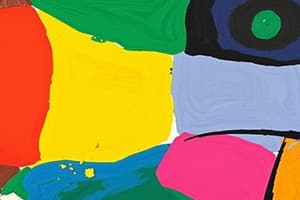Podcast
Questions and Answers
What is an example of installation art?
What is an example of installation art?
- A self-portrait painted by an artist
- A large-scale artwork designed for a specific environment (correct)
- A statue carved from marble
- A mural in a public space
Which philosophical perspective on art suggests that art distracts from true knowledge?
Which philosophical perspective on art suggests that art distracts from true knowledge?
- Art as Emotion
- Art as Representation
- Art as Expression
- Art as Imitation (correct)
What function of art addresses public issues and promotes community pride?
What function of art addresses public issues and promotes community pride?
- Physical Function
- Cultural Function
- Personal Function
- Social Function (correct)
How does Aristotle's view of art differ from Plato's?
How does Aristotle's view of art differ from Plato's?
What type of 3D art involves designing and constructing buildings?
What type of 3D art involves designing and constructing buildings?
Which example illustrates the physical function of art?
Which example illustrates the physical function of art?
What is NOT a characteristic of sculpture?
What is NOT a characteristic of sculpture?
What does the personal function of art primarily focus on?
What does the personal function of art primarily focus on?
What are the two main purposes of art according to Aristotle?
What are the two main purposes of art according to Aristotle?
How does Kant define aesthetic judgment?
How does Kant define aesthetic judgment?
What was Leo Tolstoy's perspective on the role of art?
What was Leo Tolstoy's perspective on the role of art?
Which of the following best describes representational art?
Which of the following best describes representational art?
What differentiates non-representational art from representational art?
What differentiates non-representational art from representational art?
Which example aligns with Aristotle's interpretation of tragedy?
Which example aligns with Aristotle's interpretation of tragedy?
What is meant by 'disinterested judgment' in Kant's theory?
What is meant by 'disinterested judgment' in Kant's theory?
Which of the following is NOT considered a type of non-representational art?
Which of the following is NOT considered a type of non-representational art?
What does 'Sources of Subject' encompass in the context of art?
What does 'Sources of Subject' encompass in the context of art?
Which example best represents 'Nature' as a source of subject in art?
Which example best represents 'Nature' as a source of subject in art?
What level of meaning primarily focuses on the direct narrative or depiction of artwork?
What level of meaning primarily focuses on the direct narrative or depiction of artwork?
Which of the following levels of meaning uses symbols to convey deeper ideas?
Which of the following levels of meaning uses symbols to convey deeper ideas?
What type of content in art focuses on the viewer's personal experiences and emotions?
What type of content in art focuses on the viewer's personal experiences and emotions?
Which statement about history as a source of subject in art is accurate?
Which statement about history as a source of subject in art is accurate?
An artwork depicting a bowl of fruit primarily represents which level of meaning?
An artwork depicting a bowl of fruit primarily represents which level of meaning?
What should be considered when interpreting the 'Personal' level of meaning in art?
What should be considered when interpreting the 'Personal' level of meaning in art?
What is the primary focus of art history?
What is the primary focus of art history?
Which assumption about art highlights its connection across different cultures?
Which assumption about art highlights its connection across different cultures?
How is art appreciation different from art history?
How is art appreciation different from art history?
Which of the following art forms is classified as 2D visual art?
Which of the following art forms is classified as 2D visual art?
What is one characteristic that distinguishes 2D art from 3D art?
What is one characteristic that distinguishes 2D art from 3D art?
Which of the following best describes the emotional engagement in art?
Which of the following best describes the emotional engagement in art?
What role does culture play in the interpretation of art?
What role does culture play in the interpretation of art?
Which statement correctly summarizes the essence of visual art?
Which statement correctly summarizes the essence of visual art?
Flashcards are hidden until you start studying
Study Notes
Art History vs. Art Appreciation
- Art history examines the chronological evolution of art, styles, and artists, analyzing their historical significance.
- Art appreciation emphasizes personal engagement and interpretation of artworks, fostering emotional connections and aesthetic enjoyment.
Basic Assumptions of Art
- Art is Universal: Communicates emotions and ideas that resonate across cultures; reflects shared human experiences.
- Art is Cultural: Mirrors societal beliefs and values; influenced by historical events and social norms.
- Art Involves Experience: Engages both artists and viewers emotionally; stimulates sensory perception and personal exploration.
Visual Art Forms
- 2D Visual Arts: Artworks with height and width only, created on flat surfaces.
- Painting: Application of pigments to depict scenes or emotions.
- Drawing: Use of tools like pencils and pens for creating images.
- Printmaking: Techniques for reproducing art, such as etching and screen printing.
- 3D Visual Arts: Art with height, width, and depth, resulting in tangible forms.
- Sculpture: Creation of three-dimensional figures from materials like stone and clay.
- Architecture: Design and construction of buildings and structures.
- Installation Art: Large-scale artworks designed for specific spaces using various materials.
Functions of Art
- Physical Function: Art with practical value, e.g., a creatively designed chair.
- Social Function: Addresses public issues, e.g., community murals that promote dialogue.
- Personal Function: Serves as a medium for self-expression and introspection, e.g., self-portraits.
Basic Philosophical Perspectives
- Art as Imitation: Plato’s view that art is merely a reflection of ideal forms, potentially distracting from true knowledge.
- Art as Representation: Aristotle’s belief that art imitates reality to uncover truths and provide moral lessons through depiction of human experiences.
- Art as Disinterested Judgment: Kant’s idea that aesthetic beauty is judged objectively, beyond personal preferences.
- Art as Communication of Emotion: Tolstoy’s concept that art conveys emotions akin to language, connecting people through shared feelings.
Subject and Content in Art
- Subject Types:
- Representational Art: Depicts recognizable objects and scenes to convey emotion, e.g., landscapes and portraits.
- Non-representational Art: Focuses on shapes and colors without recognizable objects, emphasizing abstract expression.
- Sources of Subject:
- Personal Experiences: Artists portray their emotions and life events, e.g., Frida Kahlo’s self-portraits.
- Nature: Representation of natural landscapes and elements, e.g., paintings of flowers.
- History: Documenting and interpreting events, such as historical paintings.
Content and Levels of Meaning
- Content in Art: Encompasses ideas, emotions, and narratives conveyed through artistic techniques.
- Levels of Meaning:
- Literal: Straightforward content, e.g., a painting depicting fruit.
- Symbolic: Use of symbols for deeper ideas, e.g., a rose symbolizing love.
- Personal: Viewer’s emotions and beliefs influence interpretation, allowing subjective connections to the artwork.
Studying That Suits You
Use AI to generate personalized quizzes and flashcards to suit your learning preferences.




